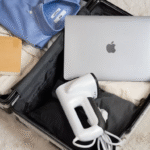Exploring the US’s national parks is one of the most enriching travel reviews, offering a chance to reconnect with nature, witness breathtaking landscapes, and enjoy sports like hiking, tenting, flora and fauna looking, and pictures. Whether or not you are planning an afternoon journey to Yosemite, a backpacking trek through the Grand Canyon, or a scenic force through the incredible Smoky Mountains, having the proper equipment is vital for both comfort and safety. Packing nicely way being organized for converting climate, variable terrain, and the unique demands of each park. A considerate method to what you convey can transform your enjoy, helping you stay targeted on the journey as opposed to disturbing about what you left at the back of.
Prioritizing The Essentials Based On Park Kind And Length
The first step to efficient packing for a country wide park experience is knowing your itinerary. A weekend getaway to a drive-in park like Shenandoah requires a unique method than every week-long backcountry excursion in Denali. Recollect the type of park you’re travelling and the sports you’ll be doing. Are you hiking, kayaking, camping, or just taking scenic pictures from lookouts? The duration of your stay, the climate of the area, and how faraway the vicinity is will all have an effect on your tools list.
For hikes and quick nature walks, fundamental items like a refillable water bottle, mild snacks, a daypack, and weather-appropriate apparel might suffice. But for longer treks or overnight camping, your packing listing expands to consist of a tent, drowsing bag, cooking substances, navigation equipment, and further layers. Continually take a look at the park’s website for traveller alerts, trail conditions, and tools hints. For example, a few parks can also require undergo canisters for food garage or advise microspikes for icy trails.
Climate plays a tremendous function too. Some country wide parks have speedy temperature swings, especially in mountainous or barren region environments. In places like Zion or Joshua Tree, temperatures can soar within the day and drop considerably at night time. Layering turns into vital in such instances. P.C. moisture-wicking base layers, insulating mid-layers like fleece or down jackets, and waterproof outer layers for surprising rain. Even in summer time, a light jacket is regularly needed all through early morning or nighttime hours. Making plans based at the park’s seasonal conditions will help you keep away from packing unnecessary gadgets and ensure you’re ready for surprising modifications.
Footwear merits special attention. Many national parks function rocky, uneven terrain. A strong, broken-in pair of hiking boots with ankle aid is ideal. Trail runners paintings for lighter hikes, but keep away from sandals or flip-flops until you’re sticking to paved pathways. Also p.c. extra socks made from merino wool or artificial blends to keep away from blisters. For multi-day hikes, blister remedy kits are a should, at the side of right foot hygiene resources like child wipes and foot powder.
Clever Apparel Alternatives For Function And Flexibility
Apparel is more than a remember of fashion whilst you’re venturing into the wilderness. Your outfit alternatives ought to prioritize capability, layering, and adaptability. Cotton clothing need to generally be avoided, mainly for base layers, as it keeps moisture and dries slowly, increasing the threat of hypothermia in chillier environments. As a substitute, opt for breathable, brief-drying materials like polyester or merino wool.
Begin with moisture-wicking undergarments and base layers that pull sweat far from your frame. Add an insulating layer like a fleece or light-weight down jacket for heat, and pinnacle it with a water resistant and windproof shell. This 3-layer system permits you to alter your body temperature as situations exchange. Convertible pants with zip-off legs provide flexibility for warm afternoons or river crossings. A extensive-brim hat and sun shades defend in opposition to solar exposure, specifically in higher elevations or barren region parks.
Gloves and beanies may additionally appear pointless in summer season, however high-elevation parks like Rocky Mountain or Mount Rainier can be chilly even in July. Likewise, rain jackets or ponchos are essential for locations like the Pacific Northwest in which weather can shift quick. A packable rain jacket is lightweight and does not absorb a good deal area, making it ideal for uncertain forecasts.
In terms of colour, opt for earth tones like browns, greens, and grays to blend into herbal environment, particularly in case you’re photographing wildlife or want a low-impact presence. Brilliant colours are better for institution safety and visibility in crowded or high-risk regions. Whichever you choose, comfort and practicality must guide your clothing alternatives.
Recall accessories. Buffs or neck gaiters are multi-cause and may be used as a headband, headscarf, or dust defend. A lightweight pair of gloves is beneficial for early morning begins or alpine trekking. If you’re making plans to swim or stumble upon rivers, percent a brief-drying towel and a couple of water shoes or sandals with straps. Those small additions make a massive difference when conditions vary in the course of the day.
Tools And Gadgets That Make A Difference
Apart from garb and footwear, there are several important gear and accessories that decorate protection, convenience, and luxury in country wide parks. A great backpack is one of the maximum essential investments for any park-goer. Select one with correct lower back support, padded straps, and ventilation. For day hikes, a fifteen–25 liter % ought to be enough, even as multi-day journeys require 50 liters or extra. Search for packs with hydration reservoirs or area to hold a couple of water bottles.
Water filtration systems are a have to in faraway areas in which potable water isn’t always to be had. Options encompass transportable filters, UV purification pens, or purification drugs. Staying hydrated is one of the most critical components of any park journey, especially in arid regions or during strenuous hikes. Collapsible water containers or bladders can also shop area and weight.
Navigation equipment are important. Even as many rely upon smartphones, GPS alerts may be weak or non-existent in far off parks. Carry a bodily map and compass, and make certain you understand a way to use them. Guidebooks or downloaded offline maps from apps like AllTrails or Gaia GPS are beneficial as backups. A small pocket book and pencil also can are available reachable for jotting notes, monitoring routes, or sketching scenic spots.
A dependable headlamp or flashlight is important if you plan to hike early inside the morning or past dusk. Usually convey more batteries. Different important electronics would possibly include a power financial institution, digicam with greater memory cards, and solar charger for longer trips. However, try and restrict electronics and include the natural surroundings—parks are an area to disconnect.
First-resource kits have to encompass basics like bandages, antiseptic wipes, ache relievers, tweezers, and personal medicines. Also don’t forget consisting of insect repellent, anti-itch cream, and sunscreen. Relying at the park, you would possibly want unique gadgets like endure spray (normally required in parts of Montana, Wyoming, and Alaska) or an emergency whistle for signaling in case of separation or injury.
Meals garage solutions range primarily based on park rules. In bear usa, a endure-evidence canister or bag is frequently mandatory. For shorter hikes, resealable snack bags, reusable containers, and lightweight utensils are enough. Continually % out what you percent in to assist hold the park’s surroundings.
Optionally Available Comforts And Leave No Trace Considerations
At the same time as no longer strictly vital, positive gadgets can decorate your park enjoy and assist preserve the herbal splendor for others to enjoy. A light-weight camp chair or sitting pad is amazing for relaxation stops or scenic lunches. A compact binocular is good for birdwatching or recognizing flora and fauna from a secure distance. A discipline guidebook enhances appreciation for plant life, fauna, and geology.
A small trash bag or reusable zip pouch enables you carry out all your waste, consisting of wrappers, meals scraps, and used tissues. Biodegradable cleaning soap, in case you must use it, must be used some distance from water sources. The Leave No Trace principle should guide all of your movements—from staying on trails to minimizing your noise stages and respecting natural world.
While tenting, use a footprint or tarp under your tent to lessen moisture and put on. Hold a small broom or brush to comb out particles. For cooking, a compact range and gasoline are more sustainable and more secure than campfires in many areas. Deliver only the cookware you want to reduce weight and waste.
To keep yourself organized, use packing cubes or coloration-coded dry luggage. This keeps your equipment easy to get right of entry to and dry during rain or river crossings. Hold gadgets like your first-resource kit, snacks, and map in without difficulty reachable outer pockets so you don’t need to dig through your p.c. whenever you forestall.
Mindfulness about nature also includes respecting other visitors. Preserve noise to a minimum, in particular early in the morning. Don’t fly drones unless authorised. Recognize path etiquette via yielding to uphill hikers and retaining pets on a leash, if allowed at all. Small movements make contributions to a higher experience for everyone.
Each national park has its own identity, its own weather patterns, policies, and spirit. Packing with care isn’t about stuffing your bag with everything you could think of, but rather about making thoughtful alternatives that replicate your appreciate for nature, your recognition of protection, and your choice for a fulfilling enjoy. When you’re organized, you’re freer to experience the instant—whether it’s standing on the brink of the Grand Canyon at dawn, walking thru historic sequoias, or looking at on the Milky Way from a quiet wasteland simple.






